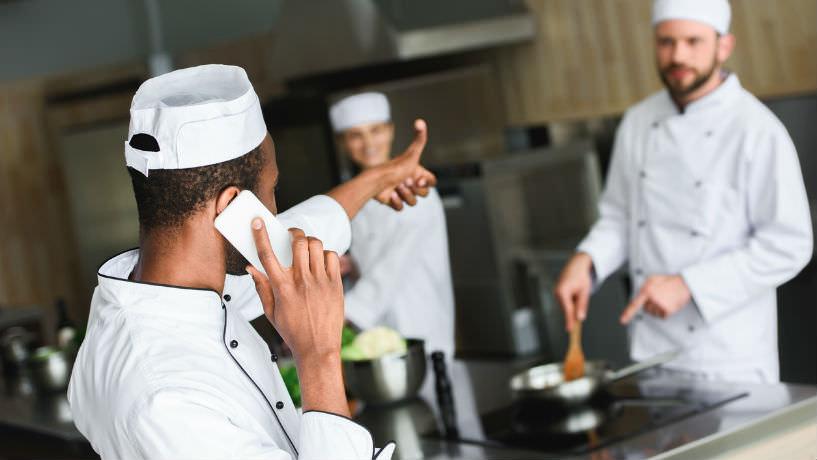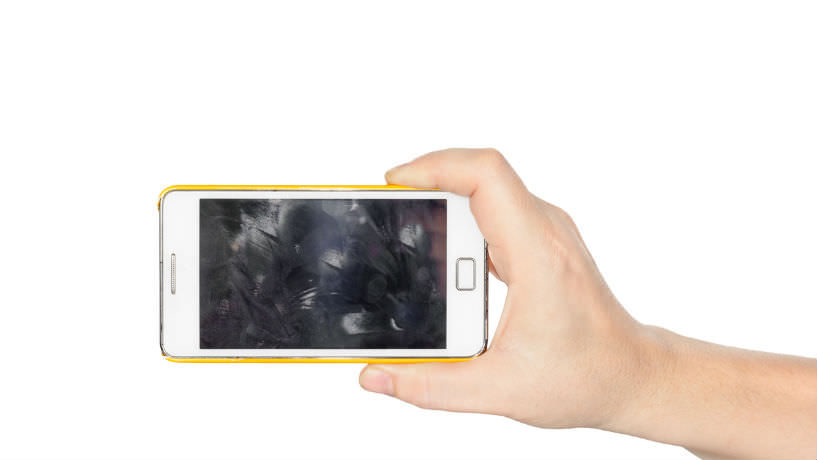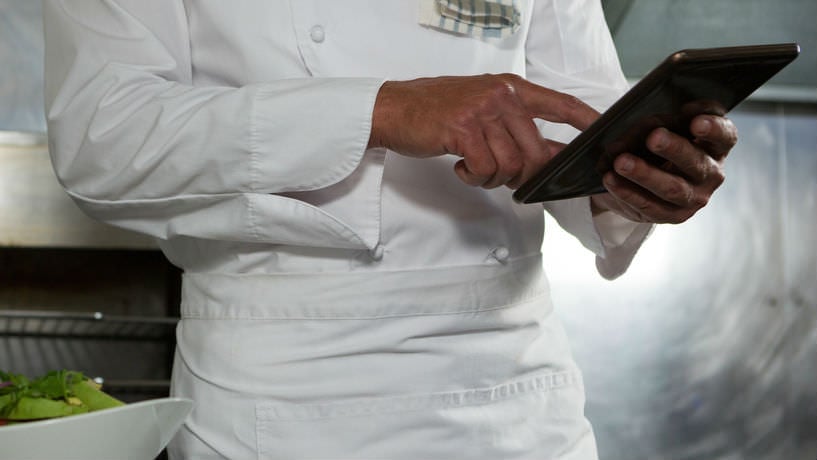
If you asked your customers if they would rather have their food prepared beside a toilet or a mobile device, how many would choose the mobile device? Probably the majority.
But what if you remind your customers that most mobile devices are covered with ten times the amount of bacteria compared to a toilet seat? The response might be quite different, and so would your customers’ reaction to seeing staff use their devices while cooking and serving food.
Five years ago Mashable's video, Your Phones Dirtier than These 5 Objects, went viral. The video compares the number of bacteria per square inch on your mobile device to the number of bacteria on a kitchen counter, doorknob, pet food dish, supermarket checkout screen and toilet seat - all of which have fewer bacteria than a mobile device.
The video is a bit sensational and dated, but its statistics and message remain relevant - especially for restaurants and other food businesses. Our mobile devices can:
- carry harmful bacteria that cross-contaminate food while it’s being prepared or served
- distract us from important food safety checks, such as time and temperature
Your device - a breeding ground for pathogens
 But how can a toilet possibly have fewer bacteria than a mobile device? While toilets tend to get cleaned frequently, mobile devices are often left out of a cleaning routine.
But how can a toilet possibly have fewer bacteria than a mobile device? While toilets tend to get cleaned frequently, mobile devices are often left out of a cleaning routine.
Most of us have good hand washing habits. We touch a door handle, shake hands with someone sniffling or use the bathroom and wash our hands afterwards, helping to eliminate the spread of bacteria.
But who hasn’t shaken a hand and then picked up their device, or been on their device while in the bathroom and not wiped their device down? A safe guess, all of us.
The bacteria on our device is easily transferred to our faces, mouths, ears and back to our hands. Unless we start to make cleaning our devices as important as washing our hands, our devices will continue to carry human and animal feces, E. coli and other dangerous types of bacteria that cause food poisoning.
A study of 200 mobile devices showed that 94.5% of devices had evidence of bacterial contamination. But don’t be paranoid; germs are everywhere, and the majority of them are harmless; it’s the ones that make you sick that cause havoc to your immune system.
Avoid cross-contamination
Allowing an employee to use or even have a mobile device at their workstation isn’t sanitary and opens your business to the dangers of cross-contamination. For example:
- A Food Handler leaves his phone on a workstation and then prepares raw meat or other hazardous foods in the same place. Bacteria from the phone can be transferred to the workstation and then to the food.
- A Food Handler uses their device while preparing an allergen-free meal. Unbeknownst to the Food Handler, earlier in the day, the device came into contact with peanut (or another common allergen). A minute trace of peanut comes into contact with the allergen-free meal causing a life-threatening anaphylactic reaction.
Limit distractions
Aside from cross-contamination dangers, mobile devices create a distraction for your staff. Those distractions can cause food safety issues. For example:
- When cooking food and watching for incoming text messages, a Food Handler shifts their attention from checking internal food temperatures to what’s happening outside of the kitchen. The result: undercooked food is served to a customer.
- When receiving a food delivery while watching a live Facebook video, a Food Handler fails to check ingredients, accepting partially thawed frozen chicken that harbours dangerous bacteria.
Protect your business with a mobile device policy
 It’s common for restaurants and other food businesses to have a mobile device policy. Some policies are more lenient than others, allowing employees to use mobile devices in certain places in the business or for particular uses.
It’s common for restaurants and other food businesses to have a mobile device policy. Some policies are more lenient than others, allowing employees to use mobile devices in certain places in the business or for particular uses.
However, the more lenient the policy, the greater the risk of food-borne illness. Some restaurants have complicated mobile device policies, for example, the device:
- can be on the Food Handler but must be silenced
- can be used but never in front of a customer
- is for emergencies only
With a complex policy, you set yourself up for debates you don’t want to have. (“It was my mom—I had to take it.”). At AIFS, we recommend a policy that does not allow the use of any mobile devices in the kitchen, storage or service areas of a food business, for example, devices cannot be:
- on a Food Handler's person at any time during their shift
- kept or used in a place other than the employee break or change room
- used without immediately wiping down the device and washing hands after use
In addition to your policy, share with your Food Handlers tips for using mobile devices hygienically. A few of our favourites are:
- Never use a mobile device while in a bathroom.
- Clean mobile devices with a microfiber cloth, or a solution of 60% water and 40% rubbing alcohol.
- Use the proper hand washing techniques after touching a mobile device.
- Don’t share your mobile device with others.
It's common for customers to ask restaurant staff to take group photos at their table. Instruct your staff to continue to take photos but to always wash their hands immediately after touching a customers device.
Bringing your mobile device policy to life
As a Manager, Owner or designated Food Safety Supervisor of a food business, the first step to changing your Food Handlers' habits is to help connect the dots between device use and food poisoning.
Don’t simply post a new policy, take the time to educate staff, using examples from this blog post to show them how dangerous using their device while handling food can be.
Once your staff know why you have a mobile device policy, they’ll be more likely to follow it. With food safety training, Food Handlers learn how surfaces like a mobile device become breeding grounds for pathogens.
AIFS offers food safety courses for Food Handlers and Food Safety Supervisors. Contact us today to learn more about our training courses and membership program.





